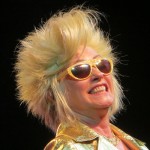It’s always amusing to look at how people in the past imagined what the future would look like. Back in the 1950s, they figured we’d have moon colonies, flying cars and personal robots by 2000. Sometimes, though, the visions of science-fiction writers drive engineers (most of whom grew up reading sci-fi) to create new and astonishing technologies. Arthur C. Clarke, who wrote “2001: A Space Odyssey” among other things, came up with the idea of the communications satellite. And a few years ago, the coolest cellphone around was a flip-phone, which looked exactly like the communicators on “Star Trek.” And TheBlot Magazine has already commented on the 3-D Printer for Food that resembled the show’s food synthesizer.
Well, it’s happened again. An engineer at the University of California at Davis has put together the basics for the “Holodeck” in “Star Trek: The Next Generation.” For those of you unfamiliar with the idea, the holodeck is a virtual reality space where the crew can go for recreation and training. Five years in interstellar space is a long time and not even I can read that much in my room.
What Oliver Kreylos did was create a platform that offers a 3-D virtual reality. Virtual reality so far had been two-dimensional at best. What is so clever about his solution, though, is that he used peripherals from an Xbox system and a headset made by Facebook. I keep asking, “Why didn’t I think of that?” (“Because you aren’t smart enough” is the likely answer).
His creation relies on the Microsoft Xbox Kinect to produce the images. As people in marketing at Microsoft say, “Controller-free gaming means full body play. Kinect responds to how you move. So if you have to kick, then kick. If you have to jump, then jump. You already know how to play. All you have to do now is to get off the couch.” Kreylos used the 3-D camera in the Kinect unit to generate his image and by putting three of them together, each covering about 120 degrees of the overall image, he got a 3-D image in 360 degrees — virtual reality.
The next trick was to find a way to display the image his trio of Kinects had made. Enter the Oculus Rift headset. Oculus Rift is a virtual reality company that Facebook bought not long ago for $2 billion. The headset receives the signal from the Kinects cameras, and bingo, you’re looking at a 3-D virtual image.
You won’t find this at Best Buy in time for Christmas, though. The prototype is rather low resolution and apparently is prone to glitches in the software. Making all the things do what you want them to do is easy if you aren’t pushing the limits of your hardware and software — but Kreylos is really pushing them. Better cameras, more processing speed and capacity and debugged software would obviously improve the platform. And then, the sales and marketing team will make it all nice and shiny.
I didn’t really want a moon colony anyway.
Jeff Myhre is a contributing journalist for TheBlot Magazine.





